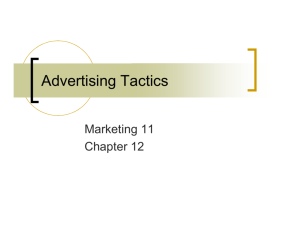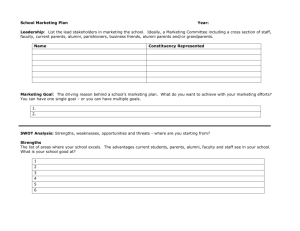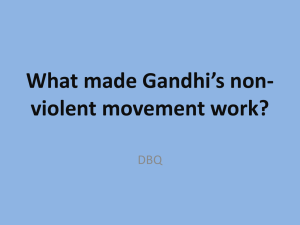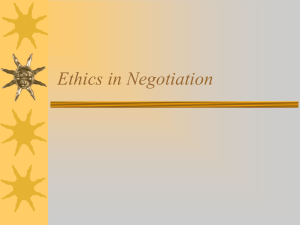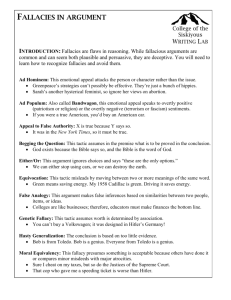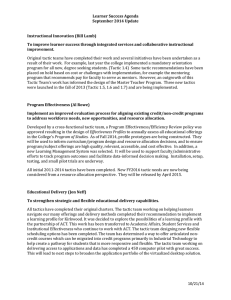Bob Anderson, Spokane Cty Fire Dist. #9 Cory Winnie, BIA
advertisement
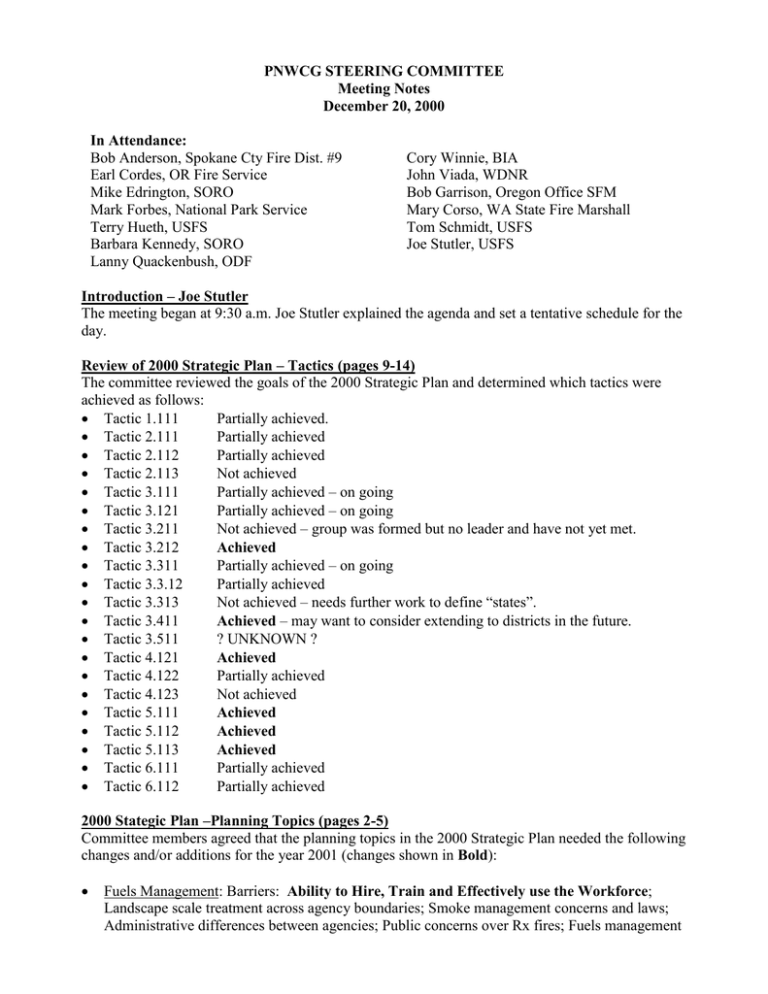
PNWCG STEERING COMMITTEE Meeting Notes December 20, 2000 In Attendance: Bob Anderson, Spokane Cty Fire Dist. #9 Earl Cordes, OR Fire Service Mike Edrington, SORO Mark Forbes, National Park Service Terry Hueth, USFS Barbara Kennedy, SORO Lanny Quackenbush, ODF Cory Winnie, BIA John Viada, WDNR Bob Garrison, Oregon Office SFM Mary Corso, WA State Fire Marshall Tom Schmidt, USFS Joe Stutler, USFS Introduction – Joe Stutler The meeting began at 9:30 a.m. Joe Stutler explained the agenda and set a tentative schedule for the day. Review of 2000 Strategic Plan – Tactics (pages 9-14) The committee reviewed the goals of the 2000 Strategic Plan and determined which tactics were achieved as follows: Tactic 1.111 Partially achieved. Tactic 2.111 Partially achieved Tactic 2.112 Partially achieved Tactic 2.113 Not achieved Tactic 3.111 Partially achieved – on going Tactic 3.121 Partially achieved – on going Tactic 3.211 Not achieved – group was formed but no leader and have not yet met. Tactic 3.212 Achieved Tactic 3.311 Partially achieved – on going Tactic 3.3.12 Partially achieved Tactic 3.313 Not achieved – needs further work to define “states”. Tactic 3.411 Achieved – may want to consider extending to districts in the future. Tactic 3.511 ? UNKNOWN ? Tactic 4.121 Achieved Tactic 4.122 Partially achieved Tactic 4.123 Not achieved Tactic 5.111 Achieved Tactic 5.112 Achieved Tactic 5.113 Achieved Tactic 6.111 Partially achieved Tactic 6.112 Partially achieved 2000 Stategic Plan –Planning Topics (pages 2-5) Committee members agreed that the planning topics in the 2000 Strategic Plan needed the following changes and/or additions for the year 2001 (changes shown in Bold): Fuels Management: Barriers: Ability to Hire, Train and Effectively use the Workforce; Landscape scale treatment across agency boundaries; Smoke management concerns and laws; Administrative differences between agencies; Public concerns over Rx fires; Fuels management PNWCG Steering Committee December 20, 2000 Page 2 may not be popular with local government; The Lack of a Common Process to Identify Communities at Risk Availability of Industry Resources: Barriers: Too many demands upon individuals; Lack of commitment of agency administrators to make people available; Fewer people available (less people in the agencies); Lack of incentives for people to participate; No Value/Benefit package to draw people into participating; Need a concept of how IMT could be integrated; Perception that structural firefighters can’t participate on IMT’s; Perception that contractors can’t be on IMT’s; Need streamline training process for integration of structure personnel; Public Safety and Health: Barriers: Policies of regulatory agencies and ours; Public awareness of the dangers of wildland fire; Effective monitoring; Lack of coordinated wildfire and Rx fire monitoring efforts; Ability to work within and understand current laws of regulatory agencies regarding smoke management; Lack of interagency contingency planning. Effective Training: Candidate pools not uniformly screened; Lack of integrated, programmatic and systematic formal training for all agencies (including emergency response agencies); The number of qualified instructors; Course content/delivery systems not set up to meet customer needs (i.e. RFD. Complete Area Coordination, Universal for Sub-geographic Areas Reflecting a Seamless Interagency Effort – NO CHANGE Public Education, Re-education and Marketing for Fuels Management Be More Cost Effective and Efficient with Fire Suppression – Barriers: Agency culture i.e. Cost not being considered a limitation –acting like have unlimited spending; Politics surrounding an incident; Overcoming public expectations vs. building dumb fireline; Conscious decision to obey existing land management decisions. Delete last sentence “All our successes erased by one mistake”. Secure Congressional, legislative, and administrative support for fully funding most efficient level (MEL) with emphasis on applying funding to initial and extended attack resources – Replace the word “federal” with “state” as feds are now at MEL whereas states are not. Enhance Personnel Safety – NO CHANGE Continue to Enhance MAC ( Multi-Agency Coordination Group) – Delete “Structural fire fighters can’t play” and “Lack of coordination State Fire Marshall Office of mobilization of resources.” Develop or Create Opportunities for private Wildland Fire Services – NO CHANGE Integration of Local and Rural Fire Departments into Wildland Organizations – committee considered adding “vice versa” to the existing title and determined that there was potential for another planning topic here. The issue will be revisited at a later date. Streamline Fire Management Fire Business Management Policies for local, State and Federal resources – NO CHANGE Fire Weather Services – NO CHANGE Implementation of the Resource Allocation Process – NO CHANGE Safely and Effectively Utilize Resources in the Wildland Interface – Delete last sentence of the barrier statement. Replace the word “need” with “Lack of” in the new final sentence. True Common Standards for Use of Aircraft – Barriers: Lack of common standards for airplane use; Agency culture; Budget restrictions; Types of airplanes selected, sometimes too expensive for all; Common definition by agencies for safe and “good enough”; Self imposed agency standards i.e. Air Service Module (ASM) use, carding issues that cause conflicts; Nationally mandated standards resulted in a lack of resources to fill critical positions. PNWCG Steering Committee December 20, 2000 Page 3 Establish an Effective Communication and Organization for PNWCG, the Membership and the PNWCG Steering Committee – Barriers: Lack of effective National Coordination; Lack of clear-cut communication process; Lack of information management; Agency constraints; Communication hardware and delivery systems; Lack of customer support organization which meets customer needs i.e. Lack of effective link between PNWCG and the broader customer base. Functional vs. Sub-geographic conflicts result in Competing Efforts and Duplication: Recommend deletion as this appears to be a duplicate Suggested New Planning Topics: Committee members agreed that the following topic needed to be added to the Strategic Plan and considered the following Goals, Objectives and Barriers: Implementation of the National Fire Plan in the Pacific Northwest Suggested Goals included: Positions filled at MEL; Fewer fires due to fuels; Reduced risk hazard; Interface more serviceable vs. defensible People trained; Seamless process for allocating money to communities; Community involvement with decisions; Improved local/rural capabilities; Congressional intent met, therefore reduced fire losses to communities and resources; Solidify interagency concept; ALL completed in the most effective manner Suggested Objectives included: Identify/Develop methods to reduce the impact of fire to communities and resources in the Pacific Northwest. Establish mechanism to enhance preparedness for IA through achieving 100% MEL Establish benchmark standards for implementing and measuring outcome (to measure accountability). Suggested Barriers: Lack of standards for identifying/ evaluating communities at risk; Lack of process to implement on the ground from an IA perspective; Lack of IA communication strategy; Lack of National coordination; direction not forthcoming or filtered; Lack of IA process to distribute money to states, local, government and tribes; No IA approach to dealing with regulatory agencies; No buy-in from all affected stakeholders; Compressed time lines; Lack of measurement standards to define success; Lack of available workforce; Ability to train in a timely manner to meet NFP; Lack of infrastructure to provide the training; Differences in expectations of end users; Lack of shared vision of each others role with NFP; Agency culture – not coordinated; NFP may not meet/match PNWCG (agency) needs. Following considerable discussion, the committee refined the new topic as follows; PNWCG Steering Committee December 20, 2000 Page 4 Topic: Implementing the National Fire Plan in the Pacific Northwest Goal 1. Effectively Coordinate Interagency efforts to implement the NFP in the Pacific Northwest. Objectives: Identify/ develop methods to reduce impacts of fire losses to communities and resources in the Pacific Northwest Strategies: Provide guidance to Sub-geographic areas to maximize the outcome of fuel management to communities. Provide guidance to Sub-geographic areas to maximize MEL for preparedness for all agencies. Other fuels, methods - non-burning. Develop Interagency coordinating mechanism that includes regulatory agencies. Goal 2. Effective Communication of the NFP issuer/results Objectives: Develop interagency coordination mechanism that includes regulatory agencies. Interagency approach to public/community education on NFP. The Top Four Issues for the 2001 Strategic Plan were identified and committees named to develop the goals, objectives, strategies and tactics for those issues and present them at the February meeting of the PNWCG Steering Committee. Those committees are: Implementation of the NFP including Fuels Management - Tom Schmidt, Mike Edrington, Terry Hueth, John Viada Availability of and the Effective Training of Resources - Mary Corso, Earl Cordes, Mark Forbes Effective Communication - Bob Anderson, Cory Winnie In order to share NFP information between now and February, Tom Schmidt will lead conference calls the first Tuesday of each week at 0800. The first conference call is scheduled for January 2, 2001. The conference number is 877-396-1925. PNWCG Steering Committee Chairman and Vice-Chairman for 2001: Members were reminded that Mark Forbes is the new PNWCG Chairman for the year 2001 with Bob Anderson as Vice-Chairman. The next meeting of the PNWCG Steering Committee was scheduled for January 17, 2001, at the Marshall House, Vancouver, WA. Meetings for the year 2001 will be held at the Marshall House in Vancouver, WA., except for the months of July, August and September. Those meetings will be held at the Northwest Coordination Center for convenience to all during fire season. Meeting adjourned at 3:20 p.m.
